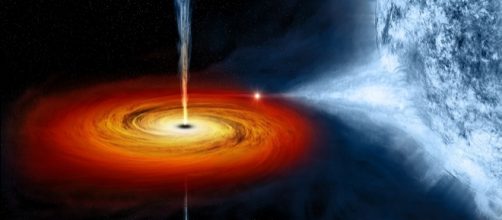Scientists have found the most persuasive evidence yet that support the existence of a mid-sized black hole in the heart of the Milky Way. If confirmed, the evidence will prove speculations that our very own galaxy has expanded by cannibalizing its neighbors.
A black hole could be hiding in the Milky Way Galaxy
Astronomers detect the presence of a potential black hole in our Galaxy. According to Science Mag, the mid-sized black hole could be lurking in the heart of the Milky Way Galaxy. The speculated black hole is unique regarding size. Science Mag adds that it is far bigger compared to black holes born from single stars but are relatively smaller compared to the giant black holes found sitting in the middle of several other galaxies.
News Week reports about how the potential black hole was marked. According to a study published in Nature Astronomy, scientist spotted a peculiar cloud that was sitting at the heart of the Milky Way. The molecular object displayed unusual properties which are not observable from other similar structures. The properties exhibited by the molecular cloud are being associated to gravitational kicks that are caused by invisible compact objects that usually weigh about 105, 000 solar masses. A group of scientists from Keio University in Japan led by Tomoharu Oka declares that the molecular cloud is a feasible Intermediate Mass Black Hole candidate.
What are Intermediate Mass Black Holes?
Black holes don’t emit their own light.
Hence, spotting them in the vast universe beyond planet Earth is a very difficult task. Scientists have successfully detected its presence by studying their influence on neighboring objects. For example, black holes which consume gas are spotted as the gas shine brightly while approaching the hole.
Over time, astronomers have discovered evidence for star-sized black holes whose masses are about ten times the mass of our Sun. Significant data have also been gathered for Supermassive Black Holes which hold millions to billions of masses in their galactic cores. Unfortunately, there is very little information on Intermediate-mass black holes (IMBH) which seem to dodge detection. The most qualified IMBH candidates are the ultraluminous x-ray sources in neighboring galaxies.
However, scientists are still debating if such bodies are indeed IMBHs or simply small black holes that ingest gas at a faster rate.
According to the study led by Tomoharu Oka, the potential black hole spotted in the heart of the Milky Way is a potential IMBH. The molecular cloud named as the CO-0.40-0.22 was detected by the Nobeyama radio telescope, a 45-meter telescope in Japan’s National Astronomical Observatory. Scientists observed a wide range of velocity movements and suspected the presence of a massive celestial body. After simulations, the group is convinced that the molecular cloud is an IMBH that weighs about 100,000 solar masses. Scientists believe that with sufficient studies and evidence, IMBHs will become the missing link that will shed light to how cosmic objects evolve and explain the creation of supermassive black holes.


